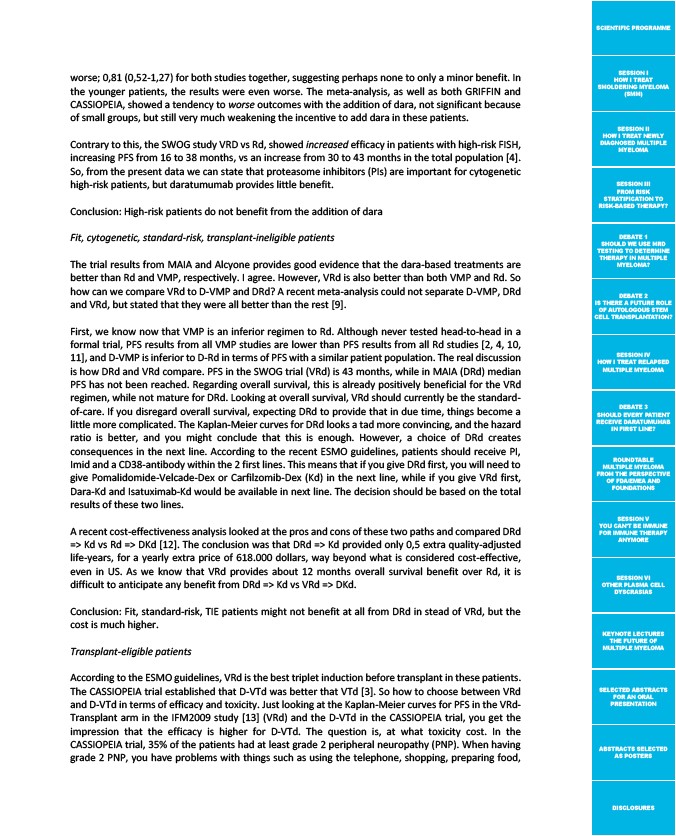
SCIENTIFIC PROGRAMME
SESSION I
HOW I TREAT
SMOLDERING MYELOMA
(SMM)
SESSION II
HOW I TREAT NEWLY
DIAGNOSED MULTIPLE
MYELOMA
SESSION III
FROM RISK
STRATIFICATION TO
RISK-BASED THERAPY?
DEBATE 1
SHOULD WE USE MRD
TESTING TO DETERMINE
THERAPY IN MULTIPLE
MYELOMA?
DEBATE 2
IS THERE A FUTURE ROLE
OF AUTOLOGOUS STEM
CELL TRANSPLANTATION?
SESSION IV
HOW I TREAT RELAPSED
MULTIPLE MYELOMA
DEBATE 3
SHOULD EVERY PATIENT
RECEIVE DARATUMUMAB
IN FIRST LINE?
ROUNDTABLE
MULTIPLE MYELOMA
FROM THE PERSPECTIVE
OF FDA/EMEA AND
FOUNDATIONS
SESSION V
YOU CAN’T BE IMMUNE
FOR IMMUNE THERAPY
ANYMORE
SESSION VI
OTHER PLASMA CELL
DYSCRASIAS
KEYNOTE LECTURES
THE FUTURE OF
MULTIPLE MYELOMA
SELECTED ABSTRACTS
FOR AN ORAL
PRESENTATION
ABSTRACTS SELECTED
AS POSTERS
DISCLOSURES
worse; 0,81 (0,52-1,27) for both studies together, suggesting perhaps none to only a minor benefit. In
the younger patients, the results were even worse. The meta-analysis, as well as both GRIFFIN and
CASSIOPEIA, showed a tendency to worse outcomes with the addition of dara, not significant because
of small groups, but still very much weakening the incentive to add dara in these patients.
Contrary to this, the SWOG study VRD vs Rd, showed increased efficacy in patients with high-risk FISH,
increasing PFS from 16 to 38 months, vs an increase from 30 to 43 months in the total population 4.
So, from the present data we can state that proteasome inhibitors (PIs) are important for cytogenetic
high-risk patients, but daratumumab provides little benefit.
Conclusion: High-risk patients do not benefit from the addition of dara
Fit, cytogenetic, standard-risk, transplant-ineligible patients
The trial results from MAIA and Alcyone provides good evidence that the dara-based treatments are
better than Rd and VMP, respectively. I agree. However, VRd is also better than both VMP and Rd. So
how can we compare VRd to D-VMP and DRd? A recent meta-analysis could not separate D-VMP, DRd
and VRd, but stated that they were all better than the rest 9.
First, we know now that VMP is an inferior regimen to Rd. Although never tested head-to-head in a
formal trial, PFS results from all VMP studies are lower than PFS results from all Rd studies 2, 4, 10,
11, and D-VMP is inferior to D-Rd in terms of PFS with a similar patient population. The real discussion
is how DRd and VRd compare. PFS in the SWOG trial (VRd) is 43 months, while in MAIA (DRd) median
PFS has not been reached. Regarding overall survival, this is already positively beneficial for the VRd
regimen, while not mature for DRd. Looking at overall survival, VRd should currently be the standard-of-
care. If you disregard overall survival, expecting DRd to provide that in due time, things become a
little more complicated. The Kaplan-Meier curves for DRd looks a tad more convincing, and the hazard
ratio is better, and you might conclude that this is enough. However, a choice of DRd creates
consequences in the next line. According to the recent ESMO guidelines, patients should receive PI,
Imid and a CD38-antibody within the 2 first lines. This means that if you give DRd first, you will need to
give Pomalidomide-Velcade-Dex or Carfilzomib-Dex (Kd) in the next line, while if you give VRd first,
Dara-Kd and Isatuximab-Kd would be available in next line. The decision should be based on the total
results of these two lines.
A recent cost-effectiveness analysis looked at the pros and cons of these two paths and compared DRd
=> Kd vs Rd => DKd 12. The conclusion was that DRd => Kd provided only 0,5 extra quality-adjusted
life-years, for a yearly extra price of 618.000 dollars, way beyond what is considered cost-effective,
even in US. As we know that VRd provides about 12 months overall survival benefit over Rd, it is
difficult to anticipate any benefit from DRd => Kd vs VRd => DKd.
Conclusion: Fit, standard-risk, TIE patients might not benefit at all from DRd in stead of VRd, but the
cost is much higher.
Transplant-eligible patients
According to the ESMO guidelines, VRd is the best triplet induction before transplant in these patients.
The CASSIOPEIA trial established that D-VTd was better that VTd 3. So how to choose between VRd
and D-VTd in terms of efficacy and toxicity. Just looking at the Kaplan-Meier curves for PFS in the VRd-
Transplant arm in the IFM2009 study 13 (VRd) and the D-VTd in the CASSIOPEIA trial, you get the
impression that the efficacy is higher for D-VTd. The question is, at what toxicity cost. In the
CASSIOPEIA trial, 35% of the patients had at least grade 2 peripheral neuropathy (PNP). When having
grade 2 PNP, you have problems with things such as using the telephone, shopping, preparing food,